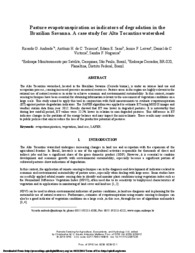Pasture evapotranspiration as indicators of degradation in the Brazilian Savanna. A case study for Alto Tocantins watershed.
Pasture evapotranspiration as indicators of degradation in the Brazilian Savanna. A case study for Alto Tocantins watershed.
Authorship: ANDRADE, R. G.; TEIXEIRA, A. H. de C.; SANO, E. E.; LEIVAS, J. F.; VICTORIA, D. de C.; NOGUEIRA, S. F.
Summary: The Alto Tocantins watershed, located in the Brazilian Savanna (Cerrado biome), is under an intense land use and occupation process, causing increased pressure on natural resources. Pasture areas in the region are highly relevant to the rational use of natural resources in order to achieve economic and environmental sustainability. In this context, remote sensing techniques have been essential for obtaining information relevant to the assessment of vegetation conditions on a large scale. This study aimed to apply this tool in conjunction with field measurements to evaluate evapotranspiration (ET) against pasture degradation indicators. The SAFER algorithm was applied to estimate ET using MODIS images and weather station data from year 2012. Results showed that ET was lower in degraded pastures. It is noteworthy that during low rainfall period, ET values were 22.2% lower in relation to non-degraded pastures. This difference in ET indicates changes in the partition of the energy balance and may impact the microclimate. These results may contribute to public policies that aim to reduce the loss of the productive potential of pastures.
Publication year: 2014
Types of publication: Journal article
Unit: Embrapa Territorial
Keywords: Evapotranspiration, Land use, SAFER, Vegetation
Observation
Some of Embrapa's publications are published as ePub files. To read them, use or download one of the following free software options to your computer or mobile device. Android: Google Play Books; IOS: iBooks; Windows and Linux: Calibre.
Access other publications
Access the Agricultural Research Database (BDPA) to consult Embrapa's full library collection and records.
Visit Embrapa Bookstore to purchase books and other publications sold by Embrapa.

